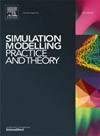行人动力学仿真中动态排队与决策建模研究
IF 3.5
2区 计算机科学
Q2 COMPUTER SCIENCE, INTERDISCIPLINARY APPLICATIONS
引用次数: 0
摘要
这项工作提出了两种不同的新颖方法来模拟行人系统中的动态队列形成和路线决策。队列形成是通过检测在特定截止距离内的行人,改变运动力并导致有组织的排队行为来建模的。引入了两种不同的方法来模拟密集的压缩地层和细长的线。参数分析评估队列维度如何依赖于模型参数。此外,我们引入了一个简单的基于排队代理识别的路线选择标准,优先考虑最省时的路线,同时考虑队列造成的延迟。动态路径变化是通过在每个潜在出口的多个预先计算的速度图之间切换来建模的。最后,结合排队和决策两种方法,研究了排队对路径选择的影响。我们的研究结果预测行人的决策受到门前排队类型的影响。本文章由计算机程序翻译,如有差异,请以英文原文为准。
On the modeling of dynamic queue formation and decision-making in pedestrian dynamics simulations
This work presents two distinct and novel approaches to simulating dynamic queue formation and route decision-making in pedestrian systems. Queue formation is modeled by detecting pedestrians within a specific cutoff distance from others already in line, altering movement forces and leading to organized queuing behavior. Two distinct methodologies are introduced to simulate dense, compressed formations and elongated, thin lines. A parametric analysis assesses how queue dimensions depend on model parameters. Additionally, we introduce a simple criterion for route selection based on the identification of queuing agents, prioritizing the most time-efficient route while accounting for delays caused by queues. Dynamic route changes are modeled by shifting between multiple pre-calculated velocity maps for each potential exit. Finally, both queuing and decision-making approaches are combined to study how queues affect route choice. Our results predict that pedestrian decision is influenced by the type of queue forming before the gates.
求助全文
通过发布文献求助,成功后即可免费获取论文全文。
去求助
来源期刊

Simulation Modelling Practice and Theory
工程技术-计算机:跨学科应用
CiteScore
9.80
自引率
4.80%
发文量
142
审稿时长
21 days
期刊介绍:
The journal Simulation Modelling Practice and Theory provides a forum for original, high-quality papers dealing with any aspect of systems simulation and modelling.
The journal aims at being a reference and a powerful tool to all those professionally active and/or interested in the methods and applications of simulation. Submitted papers will be peer reviewed and must significantly contribute to modelling and simulation in general or use modelling and simulation in application areas.
Paper submission is solicited on:
• theoretical aspects of modelling and simulation including formal modelling, model-checking, random number generators, sensitivity analysis, variance reduction techniques, experimental design, meta-modelling, methods and algorithms for validation and verification, selection and comparison procedures etc.;
• methodology and application of modelling and simulation in any area, including computer systems, networks, real-time and embedded systems, mobile and intelligent agents, manufacturing and transportation systems, management, engineering, biomedical engineering, economics, ecology and environment, education, transaction handling, etc.;
• simulation languages and environments including those, specific to distributed computing, grid computing, high performance computers or computer networks, etc.;
• distributed and real-time simulation, simulation interoperability;
• tools for high performance computing simulation, including dedicated architectures and parallel computing.
 求助内容:
求助内容: 应助结果提醒方式:
应助结果提醒方式:


